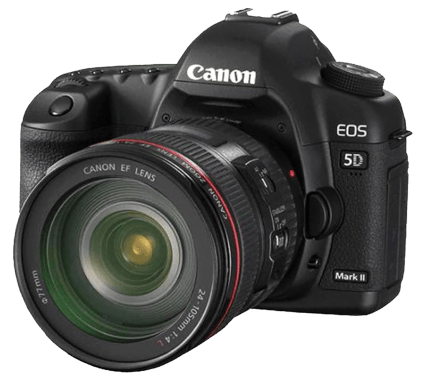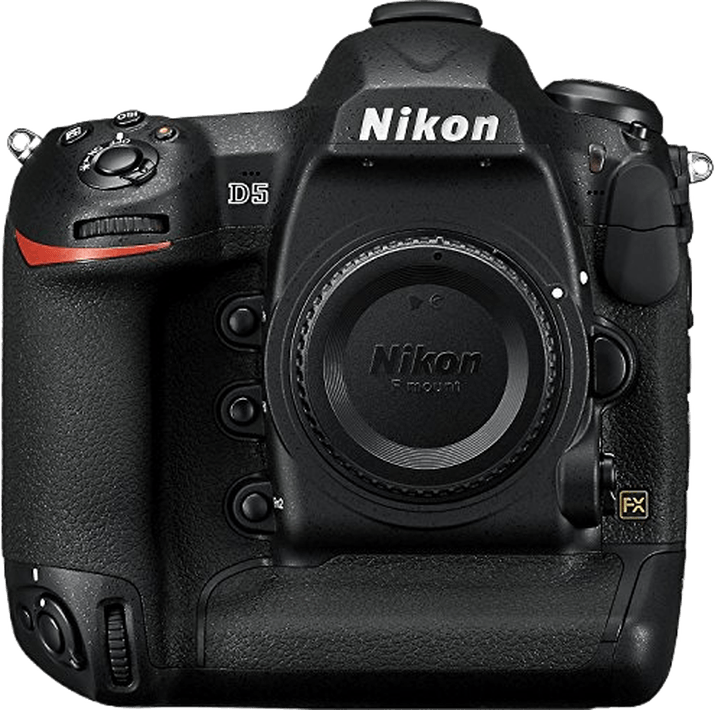Canon EOS 5D Mark II vs Nikon D5 Comparison
Canon EOS 5D Mark II

Nikon D5

The Nikon D5 outperforms the Canon EOS 5D Mark II with a score of 74 to 56. Both cameras are DSLRs, with the Canon EOS 5D Mark II released in 2008 and the Nikon D5 in 2016. The Nikon D5 has a higher launch price of $6500 compared to the Canon’s $2199. In terms of size, the Canon is smaller and lighter, measuring 152 x 114 x 75mm and weighing 850g, while the Nikon measures 160 x 159 x 92mm and weighs 1415g.
The Nikon D5’s higher score shows its superior performance in various aspects, making it a better camera overall. However, the Canon EOS 5D Mark II has its advantages, such as a more compact design and lower price. When choosing between these two cameras, it is essential to consider the individual’s priorities and budget, as both cameras offer different strengths and weaknesses.
Canon EOS 5D Mark II vs Nikon D5 Overview and Optics
The Nikon D5 emerges as the winner in the optics comparison with a score of 72/100, while the Canon EOS 5D Mark II scores 59/100. Both cameras share some specifications, such as the CMOS sensor type, full-frame sensor size, and the absence of image stabilization. They also have different lens mounts, with the Canon featuring the EF mount and the Nikon using the F FX mount.
The Nikon D5 outperforms the Canon 5D Mark II in several aspects. Firstly, the D5 has a superior processor, the Expeed 5, compared to the Canon’s Digic 4. This results in faster processing and better image quality. Moreover, the Nikon D5 boasts a higher DXOMARK score of 88, indicating a better overall sensor performance. The D5 also has a significantly faster shooting speed of 12 frames per second, compared to the Canon’s 3.9, making it more suitable for capturing fast-moving subjects.
On the other hand, the Canon EOS 5D Mark II has a slightly higher megapixel count of 21, compared to the Nikon’s 20.8. This difference, however, is minimal and might not have a significant impact on the image quality.
Taking these factors into account, it is evident that the Nikon D5 offers better optics performance than the Canon EOS 5D Mark II, primarily due to its superior processor, higher sensor score, and faster shooting speed. While the Canon 5D Mark II has a marginally higher megapixel count, it is not enough to outweigh the advantages of the Nikon D5.
Canon EOS 5D Mark II vs Nikon D5 Video Performance
The Nikon D5 emerges as the winner in the video capabilities comparison with a score of 70/100, while the Canon EOS 5D Mark II trails behind with a score of 43/100. Both cameras share some common video specifications. They have the same maximum video frame rate of 30fps, which ensures smooth video recording in both models.
However, the Nikon D5 has a clear advantage in terms of video quality, as it offers a maximum video resolution of 4K (3840 x 2160). This higher resolution provides sharper and more detailed videos compared to the Canon EOS 5D Mark II, which only supports Full HD (1920 x 1080) resolution. The Nikon D5 also features built-in time-lapse functionality, allowing users to create stunning time-lapse videos without the need for additional software or equipment.
While the Canon EOS 5D Mark II does not surpass the Nikon D5 in video capabilities, it still provides decent quality Full HD videos, suitable for casual users or those who do not require the higher resolution offered by the Nikon D5.
Taking all factors into consideration, the Nikon D5 stands out as the superior choice for video capabilities due to its 4K resolution and built-in time-lapse functionality. The Canon EOS 5D Mark II, although not as advanced in this aspect, remains a viable option for those who prioritize other features and are satisfied with Full HD video quality.
Canon EOS 5D Mark II vs Nikon D5 Features and Benefits
The Nikon D5 outperforms the Canon EOS 5D Mark II in features, scoring 74 out of 100 points, while the Canon scores 54 points. Both cameras share some common specifications, such as a 3-inch screen size for the Canon and a 3.2-inch screen size for the Nikon, no flip screen, no GPS, WIFI connectivity, and no Bluetooth.
The Nikon D5 surpasses the Canon EOS 5D Mark II in several aspects. The Nikon D5’s screen resolution is significantly higher, with 2,359,000 dots, compared to the Canon’s 920,000 dots. This higher resolution provides a sharper and clearer image when reviewing photos or navigating the menus. Additionally, the Nikon D5 features a touchscreen, making it easier and more intuitive to use.
The Canon EOS 5D Mark II, despite having a lower feature score, does have one advantage: it is lighter than the Nikon D5. This makes it more convenient for photographers who need to carry their camera for extended periods.
Considering the differences in features, the Nikon D5 is the superior choice due to its higher screen resolution and touchscreen capabilities. The Canon EOS 5D Mark II may be more suitable for photographers who prioritize a lighter camera. However, the Nikon D5’s advantages make it a better option for those who value advanced features and usability.
Canon EOS 5D Mark II vs Nikon D5 Storage and Battery
The Nikon D5 outperforms the Canon EOS 5D Mark II in storage and battery with a score of 87/100, while the Canon scores 37/100. Both cameras share the absence of USB charging and accept Compact Flash memory cards.
The Nikon D5 excels with two memory card slots, allowing for more storage and flexibility. It also supports XQD cards, providing faster write speeds. The D5’s battery life is remarkable, offering 3780 shots per charge with its EN-EL18a battery.
The Canon EOS 5D Mark II, on the other hand, has only one memory card slot and accepts fewer card types, such as UDMA and Microdrive. Its battery life is significantly shorter, with 850 shots per charge using the LP-E6 battery.
Taking these factors into account, the Nikon D5 is the clear winner in storage and battery performance, providing greater storage options and an impressive battery life. The Canon EOS 5D Mark II falls behind in this comparison, offering fewer advantages in storage and battery capabilities.
Canon EOS 5D Mark II vs Nikon D5 – Our Verdict
Are you still undecided about which camera is right for you? Have a look at these popular comparisons that feature the Canon EOS 5D Mark II or the Nikon D5:

